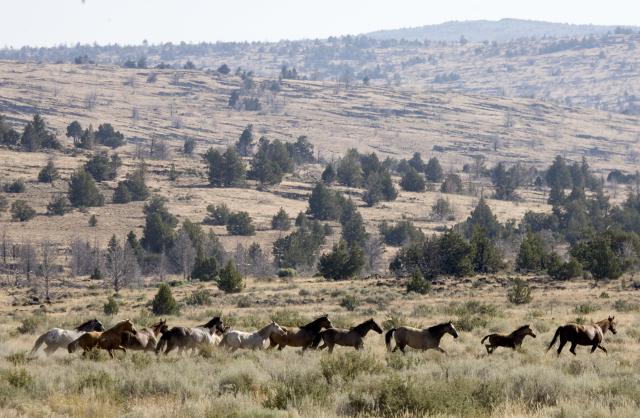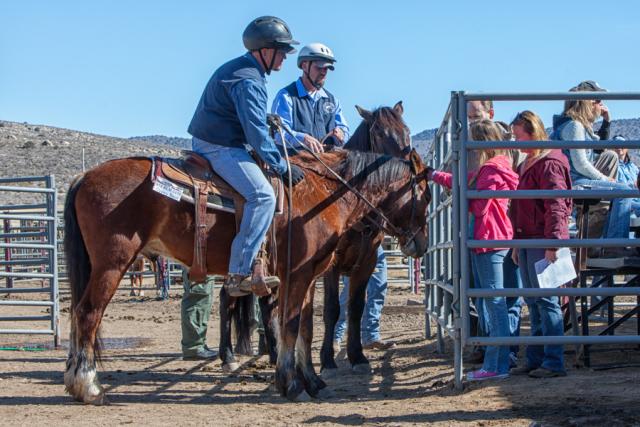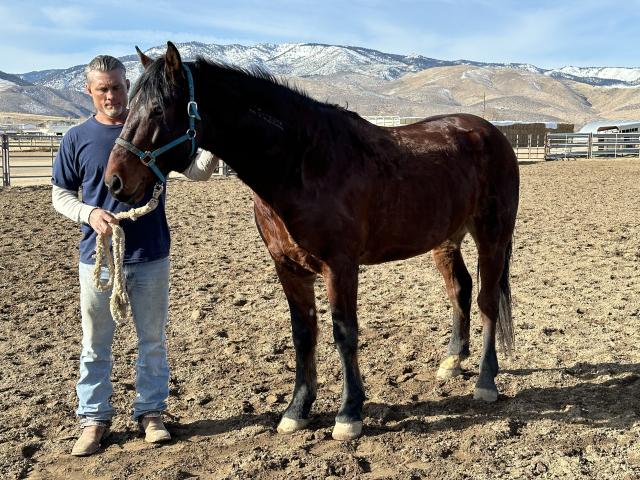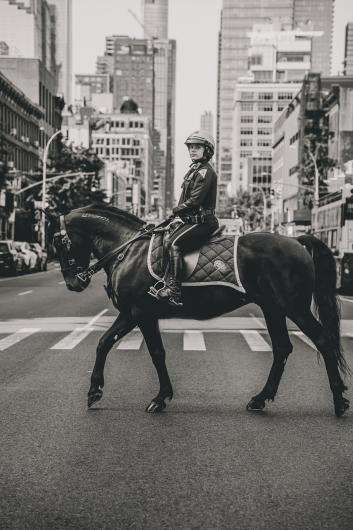Wild Horses in the Big Apple
In the bustle of one of the world’s most famous cities is a handsome police horse with a white symbol on his neck who embodies the spirit of the American West.
Wild horses and burros are some of the most resilient animals roaming Western canyons, mountains, and sage country. Descendants of horses first tamed on the vast Eurasian steppe, they are adapted to harsh climates, rugged terrain, and scarce resources. They have learned not just to survive but to thrive on America’s public lands.
It is no surprise that these animals are sought after by people from all walks of life. Some rely on the steady footing of a wild horse for backcountry trail rides. Others train and showcase them in competitions, proving just how beautiful and capable wild horses can be.
And now, another remarkable story has begun – another wild horse is heading to the streets of New York City as the newest recruit for the NYPD’s Mounted Unit. This is the story of how a wild horse, Lightning, made his journey from the wide-open West to the Big Apple.
From the Wild
For Lightning, the journey was a long one.
Wild horses on public lands have virtually no natural predators, and herds grow about 20% every year (doubling in size every 4-5 years). The Bureau of Land Management is tasked with regulating herd size to prevent damage to sensitive resources like springs and native vegetation on arid public lands, and to prevent starvation and thirst of the horses themselves. Horses’ long lives and high fertility can make it a challenge to achieve and maintain ideal herd sizes.
Lightning was born on public lands in a herd known as Twin Peaks, just outside Susanville in northern California. By the time he was born, the Twin Peaks wild horse herd had grown to more than four times what was safe and healthy for the land and the animals, which was impacting the very resources the horses needed to survive.

To protect the overall health of herds and the habitat upon which they depend, the BLM had to act. One of the ways the agency manages wild horse and burro herds is by gathering some of the excess animals from the land and making them available for adoption to qualified members of the public. Gathers are often conducted by skilled pilots in helicopters, sometimes with help from riders on horseback. Helicopter pilots can slowly maneuver horses to avoid dangerous obstacles like cliffs and rocks, while a crew on the ground operates a corral, closing the gates after horses come in.
Lightning was gathered during just such an operation, when he was approximately two years old. After he was brought in from the parched landscape, he and the other horses that came with him were examined by a veterinarian, and transported to a BLM facility, where he was slowly transitioned to living around people and having all of his needs easily met. He received a unique freeze mark on his neck that identifies him as a wild horse and got all the typical equine vaccinations required for domestic animals. Within months, Lightning was ready for his next step.
Training in Carson City
Most wild horses and burros gathered from public lands are offered to the public as they came in – wild and basically untamed. This makes them a great fit for trainers who can win their trust with patience and caring. However, about one in four wild horses are already trained through one of the various programs and partnerships the BLM supports.
Some of the most effective training programs for wild horses and burros are through the BLM’s partnerships with correctional facilities, where inmates work to gentle and train a select number of wild horses. These partnerships are the very definition of win-win – not only do the horses get much-needed training to aid in their placement into private care, but the inmates who participate in these programs typically see a lower recidivism rate compared to non-participants, meaning they are less likely to return to incarceration after release.
The BLM supports five inmate training programs located across the West and Great Plains. Lightning made his way to the program in Carson City, Nevada, at the Northern Nevada Correctional Center.

The horse training program at the Northern Nevada Correctional Center is nearly 25 years old, predating the partnership with the BLM. The program, which started in 2000, initially trained unwanted, estray horses for the Nevada Department of Agriculture before BLM joined the partnership in 2004. The BLM has since become the sole partner working with the correctional facility for training horses.
Inmates at the facility work under the supervision and stewardship of an experienced horse trainer to gentle and provide basic saddle training for wild horses. Typically, wild horses undergo about four months of training before they are offered for adoption to the public during quarterly auctions.
Some wild horses, like Lightning, are destined for something different. The BLM routinely works with other public service agencies in need of horses for their mission, from the U.S. Border Patrol to the Marine Corps and Forest Service. Lightning, remarkable for his calm demeanor and height (for a wild horse), was identified as a candidate for the NYPD.

It should come as no surprise that the horses of the NYPD are a special group. NYPD horses are typically bay, brown, black, or sorrel in color. While they can be any breed, the law enforcement agency prefers mounts with a larger build, like those with some amount of draft horse in their genes. The ideal age range is between five and 10 years old, with a height of 15.3 to 16.2 hands. The BLM assesses each horse’s conformation, health, and temperament to find the best fit for law enforcement. All horses are also required to pass a health check directed by the NYPD.
Because Lightning was destined for a vital role in public safety, he underwent more than six months of training at the Carson City facility. The extended preparation deepened his bond with his rider and sharpened his ability to respond with confidence and precision.
Justin Pope, ranch manager at the Northern Nevada Correctional Center, emphasized the significance of this work.
"The NNCC training program is pleased to be able to provide high quality and well-trained horses to our agency partners such as NYPD,” said Pope. “The partnership with NYPD speaks well of the work the offenders are capable of as well as the caliber of the horses. It provides our program the prestige of supplying horses for a notable cause and offers a sense of pride for the offender trainers."
On to the Big Apple

The NYPD has used horses as part of its force since 1858, when the majority of transportation within the city took place on hooves. Though it might seem like a contradiction for such a densely populated and modern city to still have a mounted unit as part of its police force, officers on horseback have several unique advantages. Horses can help with crowd control at events and can help reach areas that are inaccessible to officers in vehicles.
“In New York City bumper-to-bumper traffic, horses can easily go through those traffic scenarios. Mobility-wise, there’s definitely advantages,” Mounted Officer and Trainer Alban Kalaj said in a 2024 article in the New York Post.
Mounted officers are also highly popular with residents and tourists alike. In the same article, another mounted officer, Andi Gjeci, was quoted:
“We could be standing in Times Square and there could be a line of cops there. For whatever reason, people approach us before they go to the footpost or police car. We’re just more approachable.”
Lightning will join the ranks of other trained wild horses in the mounted unit – the BLM has provided six to the NYPD to date.
Though the wild horses that have joined the NYPD have already undergone training through training programs, like the one at the Northern Nevada Correctional Center, horses go through additional training to make sure they continue to thrive in the hustle and bustle of a big city, including additional sensory training and maneuverability training through obstacle courses.

The NYPD operates four horse stables throughout the city and its boroughs. The Bronx, Queens and Brooklyn each have a facility, and the horses that patrol Manhattan are cared for right in the heart of the city at the Mercedes House near Times Square and Midtown. The state-of-the-art Mercedes House facility was opened in 2015. Horses housed there are cared for by a trained staff, and have amenities that can only be described as luxury, especially for a horse coming from the parched landscapes of the West, including regular farrier and vet services, hot water showers, an endless supply of drinking water, and even an indoor exercise arena.
From the Range to a Role of Honor
Lightning’s journey from the open ranges of Northern California to Manhattan is a powerful reminder of how adaptable and capable wild horses can be. Once roaming freely across remote public lands, Lightning now plays a critical role in one of the most iconic cities in the world, helping officers keep the peace, connecting with the public, and showing the value of a trained wild horse.
As Lightning settles into his new life with the NYPD, he also carries with him the story of thousands of other wild horses and burros still in need of homes. His success is a testament to the abilities of wild horses, and to the dedication of the BLM’s partners like the Northern Nevada Correctional Center, the inmate trainers who gave him a strong foundation, and the officers who saw his potential.
Wild horses have their roots in the wide-open rugged public lands, but as Lightning proves, their future can be just as bright, no matter where their trail leads.
To adopt your own wild horse or burro, join the BLM for a special adoption event in Morrisville, New York, May 30-31, 2025 featuring up to 70 wild horses and burros. The adoption event will take place at the SUNY Morrisville Western Training Arena.
To qualify to adopt a wild horse or burro:
- Applicants must be at least 18 years old with no record of animal abuse.
- Homes must have a minimum of 400 square feet of corral space per animal, with access to food, water, and shelter.
- Corral fence must meet height requirements:
o Adult horses – 6 feet
o Yearlings – 5 feet
o Burros – 4.5 feet - Trailers must be stock type, covered, with swing gates and sturdy walls/floors.
If you're in Nevada, the next saddle-trained adoption event at the Northern Nevada Correctional Center is scheduled for June 21, 2025.
Visit our website to find additional event locations.
Jason Lutterman
Related Content
Wild Horse and Burro Adoption Experiences: Life After Adoption
From the Open Range to the Las Vegas Lights Meet Cinder from South Steens
College equine instructors to teach horsemanship using Walker—an adopted, inmate-trained wild horse
Top 5 things to know about the Wild Horse and Burro Comprehensive Animal Welfare Program
Related Stories
- Wild horses and burros find new homes at successful Wyoming adoption event
- Protecting lands and communities: Shaila Pomaikai Catan
- Strong turnout and new beginnings: 26 wild horses placed at Montana adoption event
- BLM Wild Horse & Burro Program Adoption Experiences: Life After Adoption
- Celebrating the power of public lands through tourism and community impact
